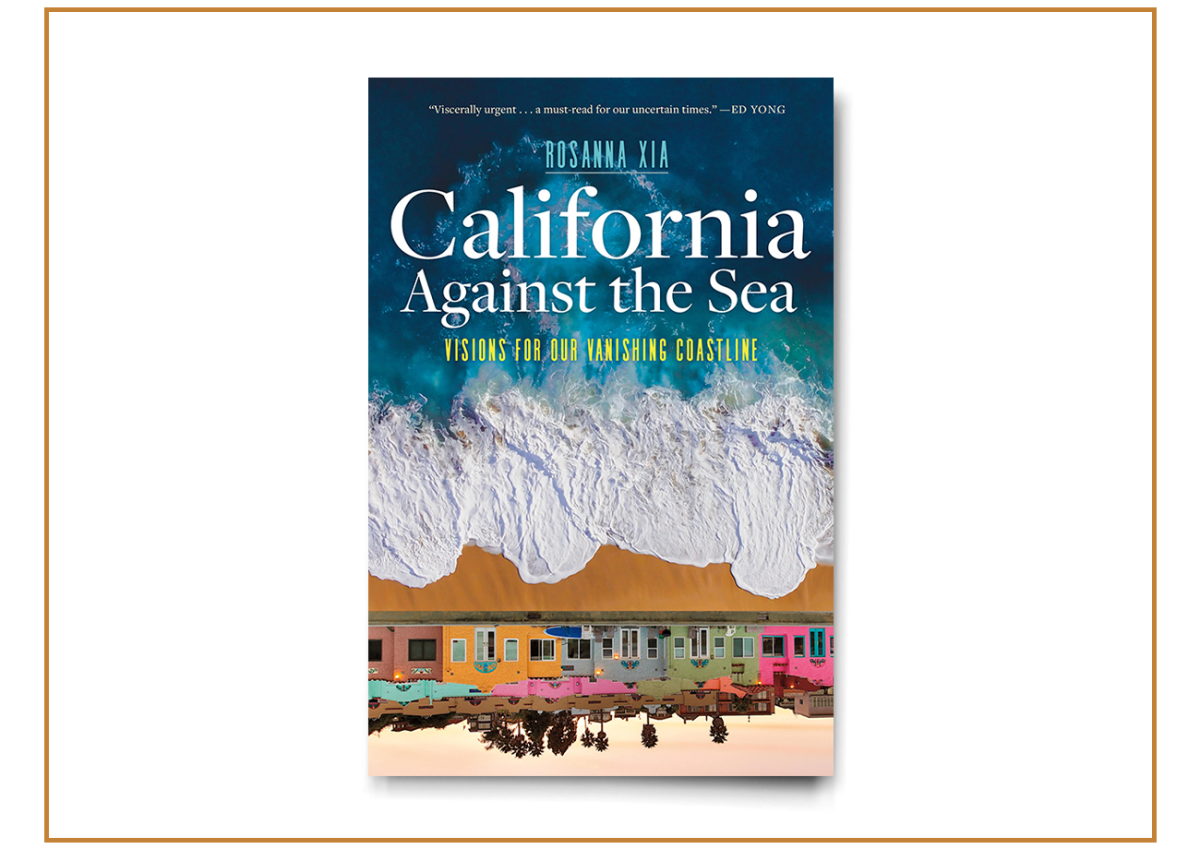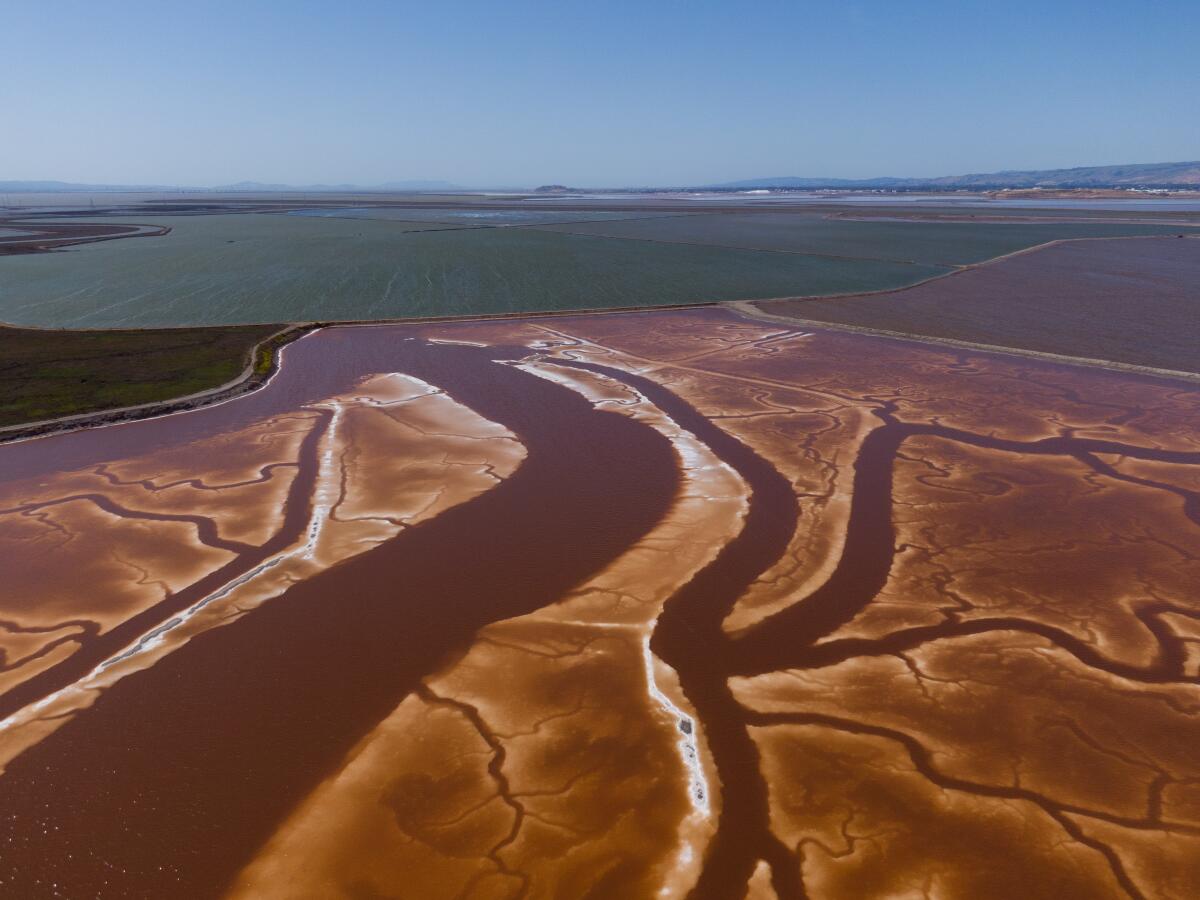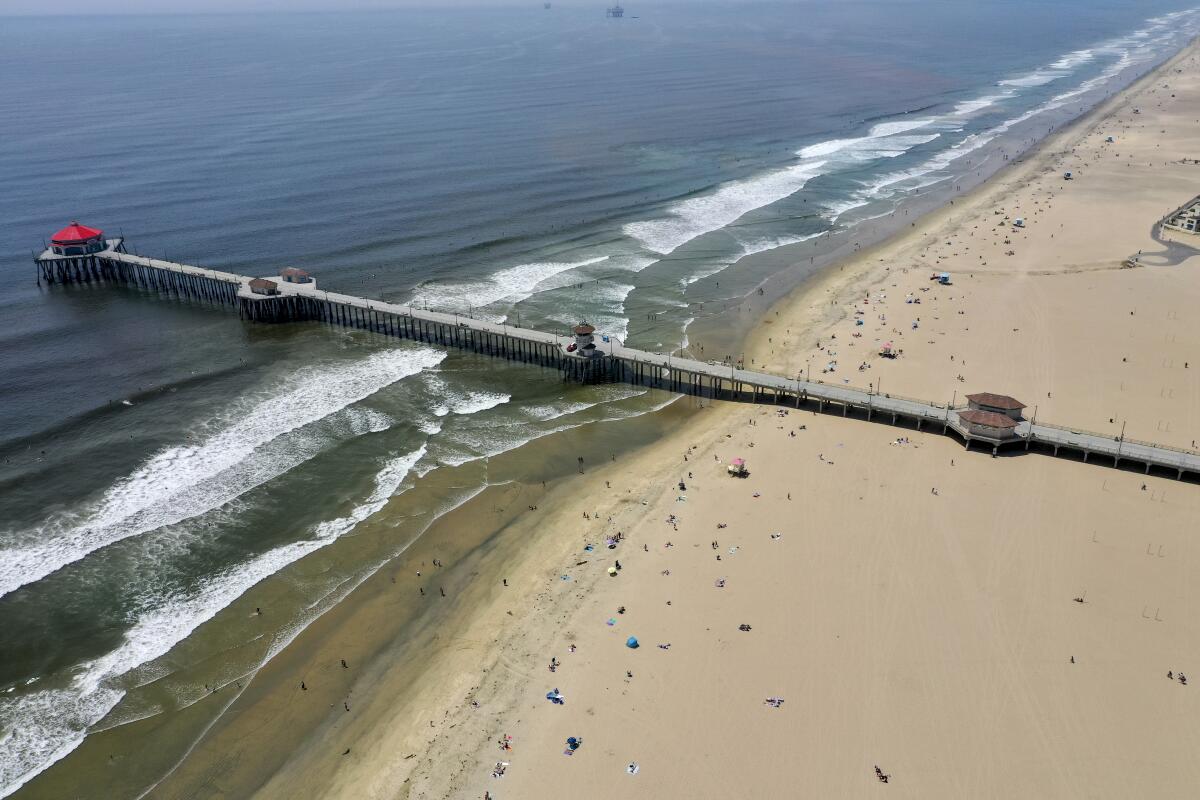Does California have what it takes to adapt to sea level rise? New book offers hope

- Share via
Let’s start with a confession: I’m not much of a beach person.
Sure, I’ve lived most of my life within a few miles of the Pacific Ocean, and spent plenty of time on the sand — enjoyed it, even. But swimming isn’t my jam. I don’t surf. Hiking in the mountains is much more fun for me than an afternoon by the water.
So when it comes to climate change, I spend less time thinking about sea level rise than other dangers.
You're reading Boiling Point
Sammy Roth gets you up to speed on climate change, energy and the environment. Sign up to get it in your inbox twice a week.
You may occasionally receive promotional content from the Los Angeles Times.
That changed recently thanks to a powerful new book by my L.A. Times colleague Rosanna Xia, a veteran environment reporter and Pulitzer Prize finalist. In “California Against the Sea: Visions for Our Vanishing Coastline,” Rosanna journeys up and down the Golden State’s much-loved waterfront, exploring the many ways that fossil fuel pollution is reshaping the Pacific shore.
“This current story of our coast does not have to end in disaster,” she writes. “We can choose to act, to reconsider, to determine a more sensible future. How we proceed can make all the difference, and it’s on all of us to forge a new ending.”

Ahead of the book’s publication next week — get your copy here! — I talked with Rosanna about the difficult politics of “managed retreat,” the importance of changing how we understand our beaches, and her hope for solutions that benefit everyone.
The following transcript of our conversation has been edited and condensed for clarity.
What made you decide to write this book?
When I first started covering the coast, I would go to all these cities and towns up and down the California coast, and I would meet people, talk to scientists, and listen to the issues being discussed in each community. Sea level rise was a recurring issue that loomed over everything, so I started to think about how to tell this bigger story about the future of our shoreline — and what we stand to lose.
Even after writing a big feature in 2019, I felt like there was so much more to say. This is a universal issue, after all, that affects every coastline in the world. Ultimately I landed at Heyday Books, a wonderful indie publisher based in Berkeley with a track record of deepening the way we connect with nature.
My editor at Heyday agreed that a book about California can speak to all these greater truths, and that there was a more nuanced story to tell beyond our stereotypical notions of coastal California. Our state provides a powerful window into the debates and existential crises that so many other communities must also reckon with.

Why are these stories relevant for everyone who lives in California, not just those lucky enough to live by the beach?
Back in the 1970s, the people of California — by a voter proposition, a ballot measure — made the philosophical stand that our shoreline cannot be owned by anybody, and therefore it belongs to everybody. It is now enshrined in our state constitution that there is no such thing as a private beach.
And the beach really is our public square — to be able to access this landscape, to enjoy it, this is so intrinsically part of our identity as Californians. This doesn’t apply just to folks who get to live by the ocean. It is the right of anyone who wants to go to the beach, or to drive along Big Sur, or to escape a heat wave farther inland.
So how do we protect this public good? What does that look like going into the future, especially when we want so many things from our coast that are in conflict with each other? Part of appreciating and resetting our relationship with the ocean — and with the way we approach sea level rise — is to recognize that the coastline is not meant to be a fixed line in the sand that we can own or control.
You talk a lot about that in the book. What does it mean exactly that the beach is not static?
We’ve engineered our landscapes with a coastal highway that firmly separates land and ocean, and with seawalls and entire neighborhoods that also create physical barriers along a shoreline that is inherently meant to move. This line in the sand changes literally every single time the tide changes — and now from sea level rise, too.
So what does it mean to acknowledge that the ocean is meant to move, and that we are meant to move with it? Those are some of the broader philosophical questions that the book starts to explore. What does it mean for Californians and non-Californians alike to maintain, to cherish, to reflect together on what we love and want from this coastline going forward?
You make the fascinating point in the book that even though the beach is part of nature, we tend to see it as part of the built environment instead — and now we need to change our perspective. I’d never thought about that before.
We often think about the beach as a fun place to visit, a place that will always be there when we go. But the beach, in reality, is a process. Sand is constantly getting grounded up and replenished, and our cliffs are constantly being shaped by waves. What does it mean to really appreciate these ancient processes that gave us the very landscapes that have made California so iconic?
One thing I loved, in the process of reporting this book, was learning about all the forgotten spaces between land and ocean — wetlands, beach dunes, all these ecosystems that have largely been paved over, flattened or erased from our coastal landscape for the sake of development. These intertidal systems are meant to be sometimes underwater, sometimes half underwater and sometimes fully above water. Wetlands and dunes can be incredible buffers from sea level rise, and they also provide habitat for a remarkable range of wildlife.

One of the most profound arguments you present in the book is the idea that even though sea level rise is scary — and already beginning to cause a lot of damage — we could choose to approach it as an opportunity to embrace change. We could start thinking about our coastline in a way that not only helps us adapt to sea level rise, but also addresses other problems — the removal of dunes and wetlands, and a history of displacing Indigenous tribes and people of color.
Do you think we have that in us? Are Californians who have benefited from a century-plus of land grabs and development along the coast capable of embracing change, rather than continuing the fight to keep things the way they are?
I hope so. And I will say, this book isn’t all depressing. There is hope at the end of the book — but I’m also asking readers to have courage to change.
For me, part of the journey of writing this book was really thinking about the words that we use to talk about climate change. “Managed retreat,” for instance — the idea of pulling away from the coast, giving more space back to the ocean — is super fraught within the climate adaptation space. The word “retreat” embodies all these war metaphors that have become baked into the way we talk about climate change. Even something as innocuous as “fighting against climate change” implies that this is a battle. But do we need to be at war with the sea? Are “seawalls” and “defending in place” and “not retreating” really the answer?
My relationship with the word “resilience” also deepened quite a bit as I wrote the book. In the old-school days, resilience meant rebuilding exactly the way things were before. But the more I reflected on this — and the more I listened to communities often left out of this conversation — the more I realized we should be asking: Do we want to build back exactly the way things were before? Who benefits when we maintain the status quo? Who continues to get left behind, and what continues to be forgotten?
You talk with a lot of beachfront residents who are fighting to maintain the shoreline they know, the version of the coast they’ve come to love. One of them stood out to me, a woman who lives in Pacifica, south of San Francisco. You wrote, “She has worked her whole life for this chance to live by the sea, and she wants more time to experience it.”
Do you not feel like adapting to sea level rise is inevitably going to be a battle between coastal property owners and the rest of us? Is there really some way we can all come together and have a dialogue rather than duking it out?
My book editor, after she read one of my earlier drafts, told me she was struck by the immense amount of empathy she felt for everyone in the book — even people she might not have agreed with. I think that’s the only way to have this conversation — to truly listen to all sides and understand why change can feel so insurmountable.
It can be easy to dismiss this issue as “rich people problems.” But how about the homeowner who spent her whole life saving money to finally buy the ugliest house on the prettiest street in town, only to find out, shortly after she moved in, that her house might need to be relocated at some unknown point in the future because the sea is moving in? Are her shock and anxiety valid? Yes, they are. So how do we not vilify folks who are facing these uncertainties? That feels like a better way to open a conversation as complicated as this one, and to think about what it means to work together.

One thing your book does incredibly well is show that rising seas aren’t just a problem for the long term — they’re doing damage right now. What are some of the ways we’re already seeing sea level rise play out in California?
Look at Capitola, near Santa Cruz, and the devastation in January after back-to-back-to-back storms hammered the coast.
There’s a scene in chapter two of the book where I’m walking along the Capitola Wharf in early 2020 with a renowned coastal scientist, and he notes that this whole area is going to feel the effects of sea level rise not far off into the future. Neither of us was necessarily thinking that “the future” was going to be in January of 2023.
All these sea level rise projections and models — they’re just guideposts. Are we really going to wait until the ocean rises 1 or 2 more feet before we take action? What happens if we get a king tide during an El Niño, which we’re expecting this winter? What happens if we get a king tide, an El Niño and multiple rainstorms in a week? What if our rivers are swollen, and the soil is so saturated from previous storms that the water has nowhere to go, especially as the ocean pushes inland and the groundwater rises up? It doesn’t take much for things to hit a threshold that is already 1, 2, 3 feet higher than “normal.”
How well would you say California politicians and policymakers are doing at dealing with rising waters?
There’s been a notable shift the past few years. In the last legislative cycle in Sacramento, more than a dozen bills got introduced to address sea level rise. In a state where wildfire and drought tend to dominate the climate debates, it is encouraging to see these conversations happening on sea level rise planning as well.
But there is so much more work to do. The ocean has absorbed more than 90% of the excess heat from our carbon emissions since the Industrial Revolution, and all this heat has baked in a certain amount of sea level rise that’s going to happen over the next few decades regardless of whether we stop all carbon emissions tomorrow. This is a reality we must face, no matter how much progress we end up making on reducing our fossil fuel emissions.
You wrote in your book about Gov. Gavin Newsom vetoing a bill — which sailed through the Legislature with hardly any opposition — that would have established a loan program to help local governments buy up coastal properties at risk of going underwater down the road, then rent them out to pay off the loan. Any idea why Newsom was opposed?
The veto message was pretty brief, and it basically said we needed a statewide plan on sea level rise before such an effort should be considered. The irony was not lost on those who thought this bill had finally broken through the circular notion of needing a plan in order to start planning.
The veto message also cited cost as a concern. And yes, we’re not sure how much adapting to sea level rise is going to cost. That’s one of the broader questions here: How much are we willing to pay? Either to hold on to life as we know it in California, or to start making some of these tougher changes that would be even tougher if we waited until disaster hit?
No one has clearly answered that question yet.
ONE MORE THING
I had a great time at Tuesday night’s “Ask a Reporter” event answering questions from L.A. Times readers about the clean energy transition, the things we can all do to build a safer world, and staying optimistic amid climate chaos. I also learned a ton from my colleague Rosanna Xia, who covers the California coast and is incredibly thoughtful. You can watch our conversation here.
ACTUALLY, ONE MORE

Stay tuned next week for Part 4 of Repowering the West! If you haven’t been following the series, you can catch up here.
We’ll be back in your inbox Tuesday. To view this newsletter in your Web browser, click here. And for more climate and environment news, follow @Sammy_Roth on Twitter.
Toward a more sustainable California
Get Boiling Point, our newsletter exploring climate change, energy and the environment, and become part of the conversation — and the solution.
You may occasionally receive promotional content from the Los Angeles Times.






